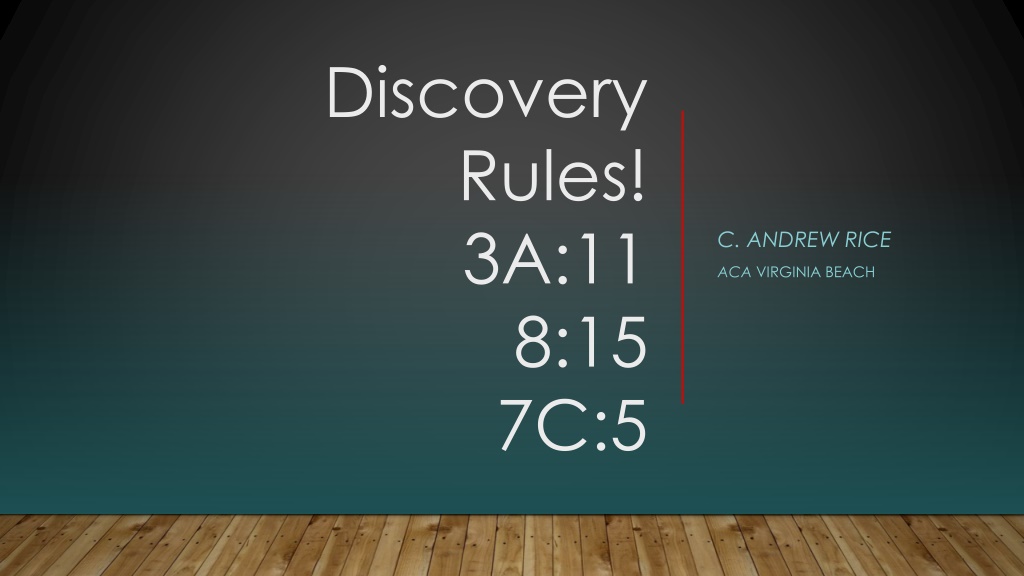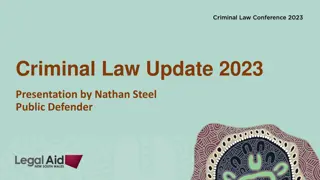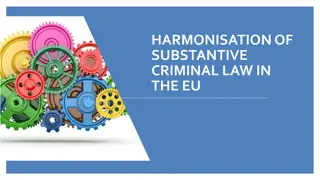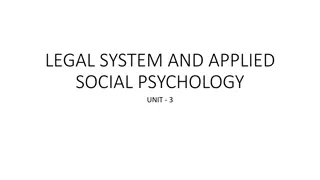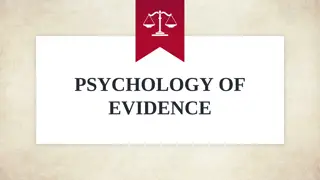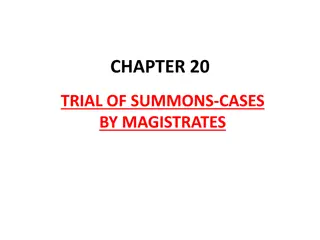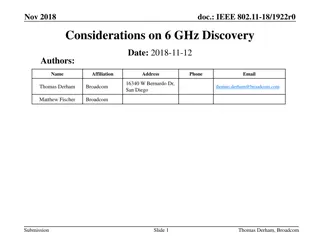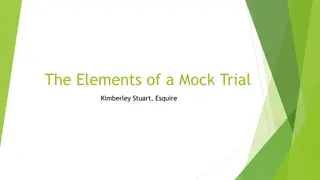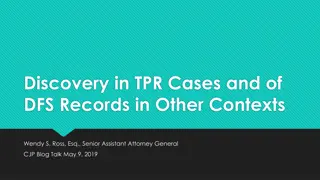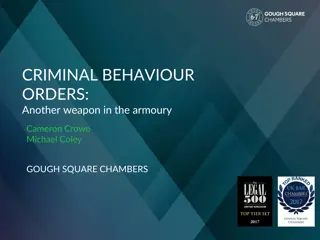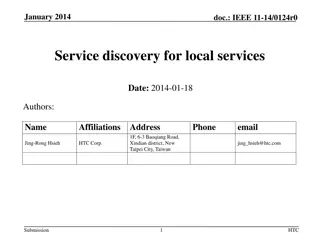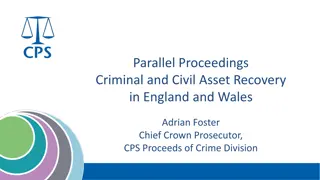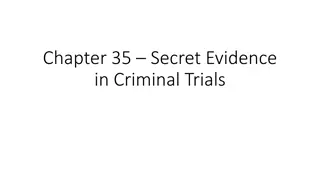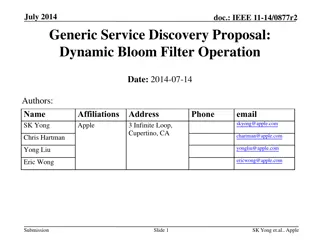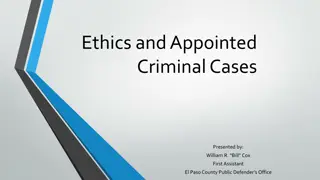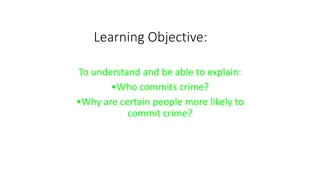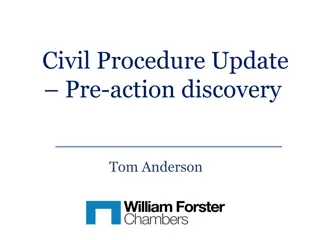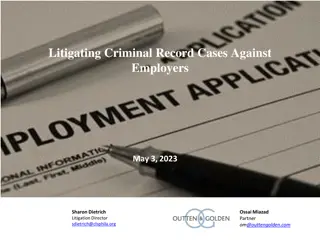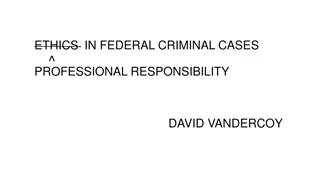Discovery Rules in Criminal Cases
Delve into the intricate world of discovery rules in criminal cases, exploring the nuances of providing evidence, protective orders, and the responsibilities of prosecutors. Uncover the provisions that govern discovery, the role of the Commonwealth's Attorney, and key changes that may impact legal proceedings.
Uploaded on Feb 16, 2025 | 0 Views
Download Presentation

Please find below an Image/Link to download the presentation.
The content on the website is provided AS IS for your information and personal use only. It may not be sold, licensed, or shared on other websites without obtaining consent from the author.If you encounter any issues during the download, it is possible that the publisher has removed the file from their server.
You are allowed to download the files provided on this website for personal or commercial use, subject to the condition that they are used lawfully. All files are the property of their respective owners.
The content on the website is provided AS IS for your information and personal use only. It may not be sold, licensed, or shared on other websites without obtaining consent from the author.
E N D
Presentation Transcript
Discovery Rules! 3A:11 C. ANDREW RICE ACA VIRGINIA BEACH 8:15 7C:5
Rule 3a:11 Circuit Court JDR Juvenile Felonies 8:15
Rule 8:15 JDR Discovery (a)Adult Criminal Case. In any cases involving adults charged with crime, the provisions of Rule 7C:5 govern discovery. (b)Juvenile Delinquency Cases. In juvenile delinquency cases, when the juvenile is charged with an act that would be a felony if committed by an adult, or in a transfer hearing or a preliminary hearing to certify charges pursuant to 16.1-269.1, the court must, upon motion timely made by the juvenile or the Commonwealth's Attorney, and for good cause, enter such orders in aid of discovery and inspection of evidence as provided under Rule 3A:11.In juvenile delinquency cases when the juvenile is charged with an act that would be a misdemeanor if committed by an adult, the court must, upon motion timely made and for good cause, enter such orders for discovery as provided under Rule 7C:5.
Subsection (a) General Provisions Subsection (b) Discovery by the Accused Subsection (c) Redaction and Restricted Dissemination Contents 3A:11 Subsection (d) Discovery by the Commonwealth Subsection (g) Protective Order Rule 3A:12
Subsection (a)2 adds exculpatory evidence to the discovery Rule: ..[D]uties of the Commonwealth s attorney to provide exculpatory and/or impeachment evidence to an accused supersede any limitation or restriction on discovery provided pursuant to this Rule. Subsection (a) General Provisions
Special Responsibilities of a Prosecutor Brady 373 US 83 Giglio 405 US 150 Rule 3.8 Professional Conduct
Subsection (a)4 provides that any discovery material filed with the court will be placed under seal at the time it is filed. Subsection (a) general provisions
Subsection (a)4 prevents a party from attempting to get around the constraints of Rule 3.6 of the Rules of Professional Conduct Purpose
(b)1 This is the first of the key changes to the Rule, and may cause many offices to significantly alter the manner in which they provide discovery In this subsection, the defense is entitled to inspect and review (but not copy) RELEVANT REPORTS PREPARED BY LAW ENFORCEMENT OFFICERS...IN CONNECTION WITH THE PARTICULAR CASE. Subsection (b) DISCOVERY BY THE ACCUSED
What are Relevant Reports? Clearly, it covers an officer s incident report and any supplements, but Does it include emails sent to the prosecutor on a case? Phone calls? Notice, the Rule does NOT specify that the reports to which it refers be written reports. What, then, is considered attorney work product? Subsection (b) DISCOVERY BY THE ACCUSED
What are Relevant Reports? (II) Cf. (b)6: The Rule does not authorize discovery or inspection of the Commonwealth s, work product internal reports, witness statements, memoranda, correspondence, legal research or other internal documents prepared by the office of the Commonwealth s attorney or its agents in anticipation of trial. Subsection (b) DISCOVERY BY THE ACCUSED
What are Relevant Reports?(III) For purposes of the Rule, what is work product? For purposes of the Rule, are police officers no longer agents of the Commonwealth attorney? Subsection (b) DISCOVERY BY THE ACCUSED "[W]here an agency is involved in the investigation or prosecution of a particular criminal case, agency employees become agents of the Commonwealth for purposes of Rule 3A:11 Commonwealth v. Ramirez, 20 Va. App. 292, 456 S.E.2d 531 (1995)
(b)2(A): While the Commonwealth has previously not been required to share written or recorded statements or the substance of any oral statements made by the accused to anyone other than law enforcement officers, the new rule requires that such statements be provided in discovery. Subsection (b) DISCOVERY BY THE ACCUSED
(b)2(C): Such statements made to a co-defendant or co- conspirators that the Commonwealth intends to use at trial must also be disclosed to the defense in discovery. Subsection (b) DISCOVERY BY THE ACCUSED
(b)3: Looks the same but it is not. The court has added the word recordings to be allowed to be copied. BWC could have to be copied. Subsection (b) DISCOVERY BY THE ACCUSED
(b)4(A): The Commonwealth must provide the report of any expert it intends to use at trial or sentencing, along with the expert s contact information. If there is no written report, then a summary of the expert s conclusions must be provided to the defense Subsection (b) DISCOVERY BY THE ACCUSED
(b)5: Provide to the accused a list of the names and, if known, the addresses of all persons who are expected to testify on behalf of the Commonwealth at trial or sentencing. This provision is subject to subpart (c)(l) of this Rule and to any protective orders entered by the court pursuant to subpart (g). Subsection (b) DISCOVERY BY THE ACCUSED
Subsection (c) Redaction and Restricted Dissemination Material
(c)1(A): The Commonwealth may redact dates of birth and social security numbers for any person whose identity must be revealed to the defense. The address, telephone number, email address and place of employment of any victim as defined in 19.2-11 et all Subsection (c) Redaction and Restricted Dissemination Material
BUT (New Hearing Alert!) the defendant may move the court to compel the Commonwealth to disclose that personal information. The court may order that the information be designated Restricted Dissemination Material (RDM). Subsection (c) Redaction and Restricted Dissemination Material
RESTRICTED DISSEMINATION MATERIAL (c)2(B) RDM is that which would result in cognizable danger to the safety or security of a witness or victim; or Would result in cognizable danger of a witness being intimidated or tampered with; or Subsection (c) Redaction and Restricted Dissemination Material
RESTRICTED DISSEMINATION MATERIAL (II) May compromise an ongoing criminal investigation or confidential law enforcement technique; or Relates to the statement of a child victim or witness 14 years of age Subsection (c) Redaction and Restricted Dissemination Material
RESTRICTED DISSEMINATION MATERIAL (III) (New Form Alert!) The Commonwealth s attorney must execute a document certifying that the material qualifies as RDM unless the attorney for the accused agrees to the designation Subsection (c) Redaction and Restricted Dissemination Material
RESTRICTED DISSEMINATION MATERIAL (IV) RDM may only be disclosed to the attorney for the accused Defense attorney cannot reproduce, copy or disseminate RDM in any way. (c)(2)(iii) Subsection (c) Redaction and Restricted Dissemination Material
RESTRICTED DISSEMINATION MATERIAL (V) Where a defendant is not represented by counsel (New Hearing Alert!), the Commonwealth must move the court to limit the scope of discovery Subsection (c) Redaction and Restricted Dissemination Material
(d)4: Requires defense to notify the Commonwealth in writing of the intent to use expert testimony at trial or sentencing, and provide the same information that the Commonwealth is required to give pursuant to (b)4. Subsection (d) Discovery by the Commonwealth
(d)5: Requires defense to provide the Commonwealth a list of witnesses it intends to use at trial or sentencing, and provide the same information that the Commonwealth is required to give pursuant to (b)5. Subsection (d) Discovery by the Commonwealth
New rule: Subsection (g) Protective Orders
(g)1: Either party may petition the court to protect materials required for discovery by ordering any, all, or other conditions for disclosure. Examples are: Subsection (g) Protective Orders
Restrict public disclosure including to any website (e.g., Facebook); Restrict disclosure to any third party except expert witnesses; Authorization to withhold any personal information listed in (c)1; Place additional restricts on withholding non-exculpatory evidence Subsection (g) Protective Orders
Rule 7C:5 General District General District Beware of RDM Can t un-ring a bell. any relevant written or recorded statements or confessions made by the accused, or copies thereof and the substance of any oral statements and confessions made by the accused to any law enforcement officer; and any criminal record of the accused.
Rule 7C:5 When does this apply? Notice this is very different than Circuit Don t get in trouble with RDM But also don t hide the ball . The intent was for more information to be shared.
C. Andrew Rice 757-385-8645 Crice@vbgov.com Questions
